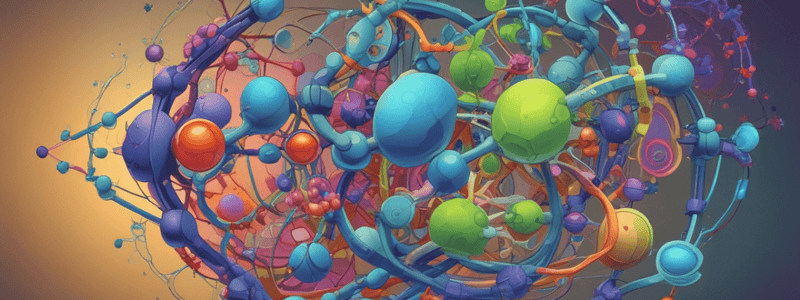Podcast
Questions and Answers
What is the primary function of exons in a gene transcript?
What is the primary function of exons in a gene transcript?
- To provide regulatory functions
- To code for proteins (correct)
- To introduce premature stop codons
- To inhibit protein synthesis
What is the result of a frameshift mutation occurring within an exon?
What is the result of a frameshift mutation occurring within an exon?
- The amino acid sequence of the protein is altered
- A premature stop codon is introduced
- The codon usage is optimized
- The reading frame of the genetic code is altered (correct)
What is the effect of exon skipping on protein function?
What is the effect of exon skipping on protein function?
- It has no effect on protein function
- It always leads to protein degradation
- It can alter protein interactions (correct)
- It increases protein complexity
What is the role of regulatory elements in exons?
What is the role of regulatory elements in exons?
What is the outcome of alternative splicing in a single gene?
What is the outcome of alternative splicing in a single gene?
What is the effect of a nonsense mutation occurring within an exon?
What is the effect of a nonsense mutation occurring within an exon?
What is the primary function of the EJC in the cytoplasm?
What is the primary function of the EJC in the cytoplasm?
What is the effect of intron insertion or deletion on gene expression?
What is the effect of intron insertion or deletion on gene expression?
What is the significance of the 5' end of the RNA exiting the nucleus first?
What is the significance of the 5' end of the RNA exiting the nucleus first?
What is the role of TAP/Mex in the EJC-mediated transport process?
What is the role of TAP/Mex in the EJC-mediated transport process?
What is the purpose of the splicing process in eukaryotic gene expression?
What is the purpose of the splicing process in eukaryotic gene expression?
What is the significance of eucromatin association with nuclear pores?
What is the significance of eucromatin association with nuclear pores?
What is the effect of the EJC on messenger RNA degradation?
What is the effect of the EJC on messenger RNA degradation?
What is the relationship between the spliceosome and the EJC?
What is the relationship between the spliceosome and the EJC?
What is the significance of the polyadenylation process in eukaryotic gene expression?
What is the significance of the polyadenylation process in eukaryotic gene expression?
What is the advantage of the 5' end of the RNA exiting the nucleus before transcription is complete?
What is the advantage of the 5' end of the RNA exiting the nucleus before transcription is complete?
Flashcards are hidden until you start studying
Study Notes
Exon Structure
- An exon is a sequence of DNA or RNA that is included in the final, mature form of a gene transcript
- Typically, exons are interspersed with introns (non-coding regions) in a gene
- Exons can be further divided into:
- Coding exons: contain the instructions for protein synthesis
- Non-coding exons: do not code for proteins, but may have regulatory functions
Alternative Splicing
- The process by which a single gene can generate multiple mRNA isoforms
- Exons are selectively included or excluded from the final mRNA transcript
- Alternative splicing allows for:
- Generation of protein isoforms with different functions
- Regulation of gene expression
- Increased complexity of the proteome
Exon Mutation
- A mutation that occurs within an exon can affect the resulting protein product
- Types of exon mutations:
- Missense mutation: alters the amino acid sequence of the protein
- Nonsense mutation: introduces a premature stop codon
- Frameshift mutation: alters the reading frame of the genetic code
- Exon mutations can lead to:
- Loss of protein function
- Gain of toxic function
- Altered protein interactions
Exon Skipping
- A type of alternative splicing where an exon is intentionally excluded from the final mRNA transcript
- Exon skipping can be:
- Constitutive: always skipped
- Tissue-specific: skipped in certain tissues or cell types
- Developmental-stage specific: skipped during specific stages of development
- Exon skipping can have significant effects on protein function and gene regulation
Exon Function
- Exons contain the genetic information necessary for protein synthesis
- Exons can also contain:
- Regulatory elements: binding sites for transcription factors and other regulatory proteins
- Untranslated regions (UTRs): regions that do not code for proteins, but may have regulatory functions
- Exon function can be influenced by:
- Epigenetic modifications: chemical modifications to DNA or histone proteins
- RNA-binding proteins: proteins that interact with RNA and influence its processing and translation
Studying That Suits You
Use AI to generate personalized quizzes and flashcards to suit your learning preferences.




